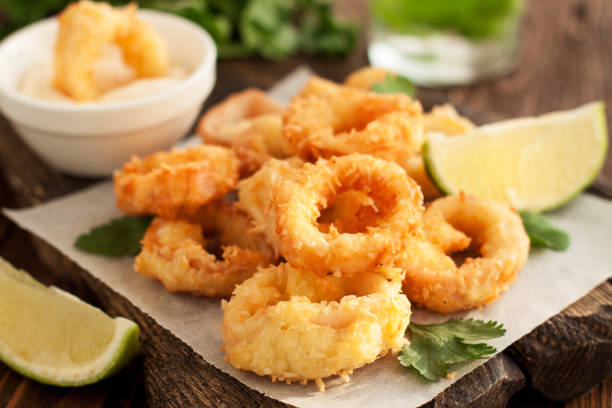Ever bit into a golden ring of crispy fried squid and thought, “What on Earth is this sorcery?” That, my friend, is calamari—a dish that manages to walk the fine line between being mysterious and mouthwatering. Whether it’s sizzling in garlic butter, curled up in a Mediterranean stew, or crowned with lemon in a seafood platter, calamari has wiggled its way into menus and hearts around the world.
But what exactly is calamari? Is it just squid with a fancy name? Where does it come from? And why does it have such a massive cult following among foodies and chefs alike?
Pull up a chair. You’re about to take a whirlwind, tongue-tingling journey through the briny, battered, and beloved universe of calamari.
What Exactly Is Calamari?
It’s Squid… but Not Just Any Squid
Let’s get one thing straight from the get-go: calamari is indeed squid. But not all squid makes the cut to be called calamari. Think of as the tender, more refined cousin of your average sea squid—kind of like the squid that went to finishing school.
In most culinary contexts, “” refers to a specific type of squid, usually the smaller, more delicate varieties that lend themselves well to grilling, frying, or sautéing.
Fun Fact: The word “” comes from the Italian word calamaro, which traces back to the Latin calamarium, meaning “ink pot.”
A Global Guest Star
Calamari’s fanbase spans continents:
-
Italy: Grilled or deep-fried, often seasoned with lemon and parsley.
-
Spain: Served as calamares a la romana—crispy rings with a side of aioli.
-
Greece: Stuffed with rice and herbs, or lightly battered and fried.
-
Japan: Turned into tempura or sliced for sushi.
-
Philippines: Known locally as adobong pusit—squid stewed in vinegar and soy sauce.
No matter the preparation, never fails to bring a burst of flavor and an irresistible texture.
Calamari in the Kitchen: Cooking Tips & Techniques
Mastering the Texture
Let’s be real. One of the biggest beefs people have with calamari is that it can go from tender to rubber band in 0.6 seconds flat. So what’s the secret?
The Golden Rule: Cook it fast and hot or low and slow. Anything in between, and you’ll be chewing on seafood bubblegum.
Quick Cooking Techniques
-
Deep-frying – Classic and crispy. The oil should be super hot (around 375°F).
-
Grilling – Great for whole or tentacles. Marinate it, then give it a quick char.
-
Sautéing – Toss it in garlic and olive oil for a minute or two and boom—perfection.
Low & Slow Options
-
Stuffed and baked – Think cheese, rice, or seasoned breadcrumbs inside a whole squid.
-
Braised – Simmered gently in tomato sauce or wine for 30+ minutes until silky soft.
Pro Tip: Always pat your dry before cooking. Water is the enemy of crispiness!
The Wild & Wonderful World of Calamari Dishes
Around the World in 7 Plates
Calamari is a global citizen, and its passport is well-stamped. Here’s a taste of where you might find it and how it’s served:
-
USA: Fried with marinara sauce—your classic bar snack with a zesty kick.
-
Japan: Squid sashimi (ika) or grilled skewers (ika yaki).
-
Korea: Spicy stir-fried squid, known as ojingeo bokkeum.
-
Portugal: Grilled with olive oil and lemon, often served over rice.
-
Turkey: Lightly fried with tarator sauce (a yogurt-walnut blend).
-
Thailand: Spicy calamari salad with lime juice, chilies, and mint.
-
Morocco: tagine, slow-cooked with preserved lemons and olives.
And guess what? That’s barely scratching the surface!
Debunking Calamari Myths
Myth #1: Calamari is Just Fancy Octopus
Nope, nope, nope. Octopus and squid are different animals—literally. comes from squid, not octopus. Though they’re both cephalopods (fancy term for sea creatures with tentacles), they differ in taste, texture, and behavior.
Myth #2: You Can’t Eat the Tentacles
Wrong again. Tentacles are not just edible—they’re downright delicious. Fried to a golden crunch or grilled to smoky tenderness, they bring flavor and texture to any dish.
Myth #3: It’s Only Good Fried
Fried might get all the spotlight, but grilled, stewed, and sautéed versions deserve equal praise. It’s time we let calamari shine in all its forms.
The Nutritional Lowdown
Is Calamari Healthy?
Absolutely—when cooked right. Here’s what brings to the table:
-
High protein: Great for muscle repair and satiety.
-
Low fat: Unless deep-fried, of course.
-
Rich in vitamins and minerals: B12, potassium, zinc, and copper.
-
Omega-3 fatty acids: Beneficial for brain and heart health.
But beware the batter bath. Deep-frying adds calories and fat, so moderation (or alternate methods like grilling) is key.
Calamari FAQs
What does calamari taste like?
Mild, slightly sweet, and a little bit like the sea. When fresh, it doesn’t have that fishy funk—just clean, briny flavor with a texture that’s chewy (in a good way).
How do you know if calamari is cooked?
It turns opaque and firms up—usually within 2 minutes of high heat. Overcooked gets tough and rubbery. Timing is everything.
Can you eat calamari raw?
Yes, if it’s sushi-grade and ultra-fresh. Raw (often seen in Japanese cuisine) is tender and subtly flavored.
Is frozen calamari any good?
Surprisingly, yes. Flash-frozen can retain great texture and flavor if thawed properly. Just skip the microwave and go for a cold water soak.
Unexpected Calamari Uses
Sure, you’ve had as an appetizer or a main course, but did you know it can sneak into:
-
Pasta dishes (like linguine with squid ink sauce)
-
Ceviche (marinated in citrus juice and herbs)
-
Tacos (think: spicy grilled calamari with avocado crema)
-
Ramen bowls (as a topping alongside egg and pork)
This little sea creature is a culinary chameleon.
Cooking Calamari at Home: A Starter Recipe
Easy Fried Calamari
Ingredients:
-
1 lb (rings and tentacles)
-
1 cup all-purpose flour
-
1/2 cup cornmeal (optional for extra crunch)
-
Salt & pepper
-
1 tsp paprika or garlic powder (optional)
-
Vegetable oil (for frying)
-
Lemon wedges
-
Marinara or garlic aioli
Instructions:
-
Rinse and dry the thoroughly.
-
Mix flour, cornmeal, salt, pepper, and optional spices in a shallow bowl.
-
Heat oil in a deep skillet to 375°F.
-
Dredge in the flour mixture and fry in batches (about 2 minutes).
-
Drain on paper towels and serve hot with lemon and dipping sauce.
Voila! You’ve just made a restaurant favorite at home.
Conclusion: Calamari, You Old Charmer
Calamari isn’t just squid—it’s an experience. A story told in sizzles, spices, sauces, and sometimes, sticky fingers. From the coasts of Italy to the night markets of Seoul, this ocean delicacy continues to captivate taste buds with its versatility and charm.
So the next time you spot “calamari” on the menu, don’t just skim past it—embrace it. Whether you’re frying it up for friends, grilling it under the stars, or adding it to your weeknight pasta, calamari always brings something special to the table.
Hungry for More?
Try experimenting with:
-
and chorizo skewers
-
Squid ink risotto with grilled
-
Greek-style calamari salad with feta and olives
Let your inner sea chef shine!







